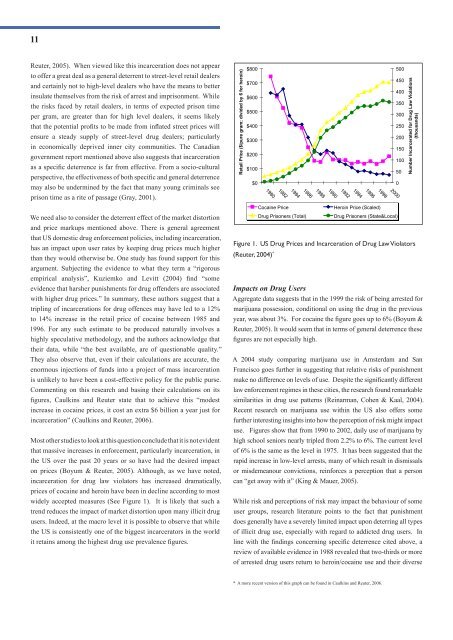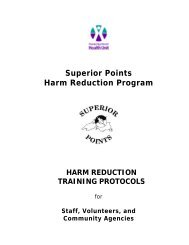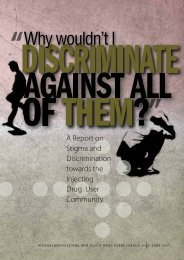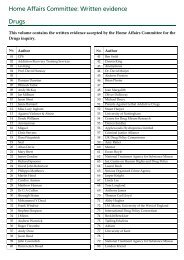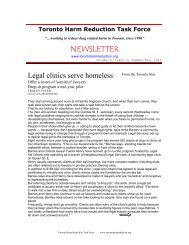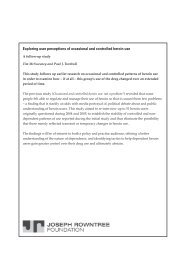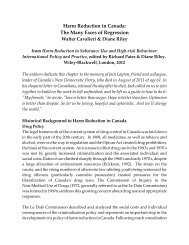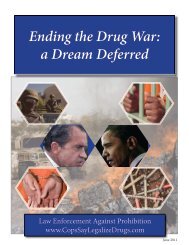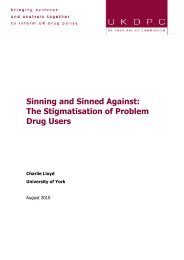11Reuter, 2005). When viewed like this incarceration does not appearto <strong>of</strong>fer a great deal as a general deterrent to street-level retail dealersand certainly not to high-level dealers who have the means to betterinsulate themselves from the risk <strong>of</strong> arrest and imprisonment. Whilethe risks faced by retail dealers, in terms <strong>of</strong> expected prison timeper gram, are greater than for high level dealers, it seems likelythat the potential pr<strong>of</strong>its to be made from inflated street prices willensure a steady supply <strong>of</strong> street-level drug dealers; particularlyin economically deprived inner city communities. <strong>The</strong> Canadiangovernment report mentioned above also suggests that incarcerationas a specific deterrence is far from effective. From a socio-culturalperspective, the effectiveness <strong>of</strong> both specific and general deterrencemay also be undermined by the fact that many young criminals seeprison time as a rite <strong>of</strong> passage (Gray, 2001).Retail Price ($/pure gram; divided by 6 for heroin)$800$700$600$500$400$300$200$100$020001998199619941992199019881986198419821980500450400350300250200150100500Number Incarcerated for <strong>Drug</strong> Law Violations(thousands)We need also to consider the deterrent effect <strong>of</strong> the market distortionand price markups mentioned above. <strong>The</strong>re is general agreementthat US domestic drug enforcement policies, including incarceration,has an impact upon user rates by keeping drug prices much higherthan they would otherwise be. One study has found support for thisargument. Subjecting the evidence to what they term a “rigorousempirical analysis”, Kuziemko and Levitt (2004) find “someevidence that harsher punishments for drug <strong>of</strong>fenders are associatedwith higher drug prices.” In summary, these authors suggest that atripling <strong>of</strong> incarcerations for drug <strong>of</strong>fences may have led to a 12%to 14% increase in the retail price <strong>of</strong> cocaine between 1985 and1996. For any such estimate to be produced naturally involves ahighly speculative methodology, and the authors acknowledge thattheir data, while “the best available, are <strong>of</strong> questionable quality.”<strong>The</strong>y also observe that, even if their calculations are accurate, theenormous injections <strong>of</strong> funds into a project <strong>of</strong> mass incarcerationis unlikely to have been a cost-effective policy for the public purse.Commenting on this research and basing their calculations on itsfigures, Caulkins and Reuter state that to achieve this “modestincrease in cocaine prices, it cost an extra $6 billion a year just forincarceration” (Caulkins and Reuter, 2006).Most other studies to look at this question conclude that it is not evidentthat massive increases in enforcement, particularly incarceration, inthe US over the past 20 years or so have had the desired impacton prices (Boyum & Reuter, 2005). Although, as we have noted,incarceration for drug law violators has increased dramatically,prices <strong>of</strong> cocaine and heroin have been in decline according to mostwidely accepted measures (See Figure 1). It is likely that such atrend reduces the impact <strong>of</strong> market distortion upon many illicit drugusers. Indeed, at the macro level it is possible to observe that whilethe US is consistently one <strong>of</strong> the biggest incarcerators in the worldit retains among the highest drug use prevalence figures.Cocaine PriceHeroin Price (Scaled)<strong>Drug</strong> Prisoners (Total)<strong>Drug</strong> Prisoners (State&Local)Figure 1. US <strong>Drug</strong> Prices and <strong>Incarceration</strong> <strong>of</strong> <strong>Drug</strong> Law Violators(Reuter, 2004) *Impacts on <strong>Drug</strong> UsersAggregate data suggests that in the 1999 the risk <strong>of</strong> being arrested formarijuana possession, conditional on using the drug in the previousyear, was about 3%. For cocaine the figure goes up to 6% (Boyum &Reuter, 2005). It would seem that in terms <strong>of</strong> general deterrence thesefigures are not especially high.A 2004 study comparing marijuana use in Amsterdam and SanFrancisco goes further in suggesting that relative risks <strong>of</strong> punishmentmake no difference on levels <strong>of</strong> use. Despite the significantly differentlaw enforcement regimes in these cities, the research found remarkablesimilarities in drug use patterns (Reinarman, Cohen & Kaal, 2004).Recent research on marijuana use within the US also <strong>of</strong>fers somefurther interesting insights into how the perception <strong>of</strong> risk might impactuse. Figures show that from 1990 to 2002, daily use <strong>of</strong> marijuana byhigh school seniors nearly tripled from 2.2% to 6%. <strong>The</strong> current level<strong>of</strong> 6% is the same as the level in 1975. It has been suggested that therapid increase in low-level arrests, many <strong>of</strong> which result in dismissalsor misdemeanour convictions, reinforces a perception that a personcan “get away with it” (King & Mauer, 2005).While risk and perceptions <strong>of</strong> risk may impact the behaviour <strong>of</strong> someuser groups, research literature points to the fact that punishmentdoes generally have a severely limited impact upon deterring all types<strong>of</strong> illicit drug use, especially with regard to addicted drug users. Inline with the findings concerning specific deterrence cited above, areview <strong>of</strong> available evidence in 1988 revealed that two-thirds or more<strong>of</strong> arrested drug users return to heroin/cocaine use and their diverse* A more recent version <strong>of</strong> this graph can be found in Caulkins and Reuter, 2006.
12criminal patterns within three months after release from detention(Bertram et al, 1996). Moreover, Jeffrey Fagen’s study <strong>of</strong> thousands<strong>of</strong> drug <strong>of</strong>fenders found not only that punishment failed to deter butalso that “the probability <strong>of</strong> rearrest increased with the length <strong>of</strong> thesentence.” “Findings from a number <strong>of</strong> studies,” Patricia Eriksonconcluded in 1990, “consistently indicate that the perceived certaintyand severity <strong>of</strong> punishment are insignificant factors in deterring use”(Bertram, et al 1996).For problematic drug users, it is perhaps not surprising that the threat <strong>of</strong>punishment will have a limited effect. Many suffer from other seriousproblems and it can be argued that being punished is not an over-ridingconcern for them. For example, according to the US government’sAlcohol, <strong>Drug</strong> Abuse and Mental Health Administration, 53% <strong>of</strong> drugusers have a diagnosable mental disorder. Many hard-core users ininner cities already lead such high-risk lives on the streets that prisonis not perceived as a much riskier or more threatening alternative(Bertram, et al, 1996).Indications that punishment as a deterrent has limited utility arebolstered by research suggesting that factors other than arrest andincarceration have led heavy drug users to quit. Evidence suggests,for example, that many users have been led to control or give up theirdrug use because the toll on personal relationships and home andwork lives was too high and the rewards for quitting were attractive(Bertram et al, 1996). One early study exploring the reasons whyheroin addicts stopped drug use found that not one <strong>of</strong> the adult menand women mentioned concern about punishment as the reason fortheir first attempt to stop using heroin, and only 13% <strong>of</strong> the juvenileusers did. <strong>Drug</strong>-related physical or family problems, the desire tochange a life pattern, or the expense <strong>of</strong> maintaining a habit were muchmore commonly cited reasons (Brown et al, 1971). <strong>The</strong> latter variablefits in with the idea that inflating drug prices through increasing risksto dealers can impact prevalence rates. It does little, however, tosuggest that the threat <strong>of</strong> incarceration will deter individuals fromdrug use. A 1991 study revealed a similar relationship between heavycocaine users and motivations leading to the cessation <strong>of</strong> use. <strong>The</strong>fear <strong>of</strong> arrest was well below other factors including health problems,financial difficulties, problems at work and pressure from spouseor lover (Waldorf, Reinarman & Murphy, 1991). Looking beyondthe US context, it is interesting to note that a recent study in the UK(Reuter and Stevens, 2008) has fashion and popular culture as the firston its list <strong>of</strong> factors which influence levels <strong>of</strong> drug use, and is “quitepessimistic” that law enforcement measures, or even drug policyinterventions more broadly, can reduce drug use in general. In support<strong>of</strong> this belief, the study points to the great upturn in the use <strong>of</strong> cannabisin societies from Finland to Australia that took place in the 1990s; therange <strong>of</strong> countries involved embraced policy-positions from the toughto the liberal, yet none <strong>of</strong> them seemed to make much difference,leading these authors to conclude that global popular culture playedan important, if unspecified, role in this wave <strong>of</strong> youthful drug use.COSTS OF INCARCERATIONHaving examined the potential benefits <strong>of</strong> incarceration, the nextsection <strong>of</strong> the report examines the costs <strong>of</strong> this policy choice. Herewe explore the issue <strong>of</strong> cost in terms <strong>of</strong> both financial and variedcollateral impacts.Financial Costs<strong>The</strong> financial cost associated with a focus on law enforcement andincarceration within the US is high. Moreover, the methodology bymeans <strong>of</strong> which annual spending is calculated is subject to dispute,and has been modified since 2003. At the time <strong>of</strong> writing <strong>of</strong> <strong>Beckley</strong>Briefing Paper Number Seven, US Federal spending on drug controlin 2002 totaled $18.822 billion, over half <strong>of</strong> which was spent ondomestic law enforcement. <strong>The</strong> figures for annual drug control fundingnow include “only those expenditures aimed at reducing drug use”,instead <strong>of</strong> including, as previously, expenditures “associated with theconsequences <strong>of</strong> drug use”. <strong>The</strong> result <strong>of</strong> this “restructuring” is that thedrug control budget appears greatly reduced; for example, the 2002budget mentioned above, which was $18.822 billion, now stands at$10.781 billion. Significantly, the primary changes affecting the totalderive from criminal justice expenses; the costs <strong>of</strong> incarceration andprosecution <strong>of</strong> drug law <strong>of</strong>fenders are no longer included in the drugcontrol budget. This has the effect <strong>of</strong> making the proportion spenton treatment appear close to that spent on enforcement, whereas thelarge imbalance in favour <strong>of</strong> the latter was fully apparent under theformer mode <strong>of</strong> calculation. (Common Sense for <strong>Drug</strong> Policy, 2003)According to present methodology, drug control expenditure for2006, the latest year for which final spending data are available, was$13,844.1 billion (Bureau <strong>of</strong> Justice Statistics, 2008).According to the calculations <strong>of</strong> Harvard Economist Jeffrey Miron(Miron, 2008), the sum <strong>of</strong> $12.3 billion was spent keeping State andFederal drug law <strong>of</strong>fenders in prison in 2006. Such figures reflectthe fact that large-scale incarceration is an expensive policy option.Put another way, it was calculated that in the early 1990s the cost <strong>of</strong>a prison place per year was more than the cost <strong>of</strong> tuition, room andboard at Harvard. It has also been estimated that in 1996 the cost <strong>of</strong>a life sentence for a prisoner in California was $1.5 million (Stern,1998). High costs are not unique to the US. Research shows that north<strong>of</strong> the border, Canadian correctional services expenditures totalledalmost $3 billion in 2005/6. Custodial services made up 71% <strong>of</strong> thistotal, community supervision 14%, headquarters and central services14% and Parole boards, 2%. If police and court costs are included,the figure exceeds $10 billion. <strong>The</strong> cost <strong>of</strong> incarcerating a Federalmale prisoner was $87,665 per annum, with female prisoners aroundtwice the cost (PrisonJusticeCa, 2008.) Meanwhile, the UK spendsproportionately more on law and order than any <strong>of</strong> the other stateswithin the Organization for Economic Cooperation and Development,including the US. Much <strong>of</strong> that investment goes into incarcerationwith the annual cost <strong>of</strong> keeping an individual in prison being £37,500in 2008. Furthermore, research by the UK based Centre for Crime and


